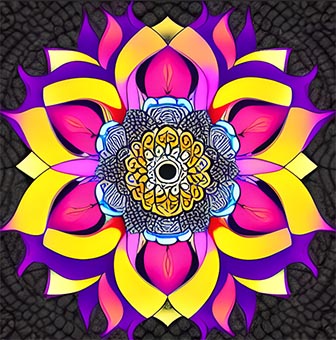The lotus mandala, a symbol that seems to effortlessly bridge the gap between the artistic and the spiritual, has long held significance in various cultures and traditions around the world. This intricate design not only captivates the eyes with its geometric beauty but also pulls at the strings of the soul, offering messages of enlightenment, rebirth, and purity. We will unravel the layers of the lotus mandala, understanding its historic importance, spiritual significance, and how it permeates various aspects of life and art.
The Lotus Flower: An Emblem of Purity
Before we can appreciate the profundity of the lotus mandala, it is essential to understand the symbolism of the lotus flower itself. In our worldly experience, the lotus is often seen as an aquatic plant that has its roots sunk into the muddy waters of ponds and lakes but blooms above the water with remarkable splendor. It is this very characteristic – emerging unsoiled from the murky depths – that turns the lotus into a potent emblem of purity and resilience.
Different cultures have adopted the lotus to represent key spiritual concepts. In Hinduism, the lotus is associated with divine beauty and purity, with gods and goddesses often depicted seated upon the sacred flower. The lotus speaks of spiritual awakening in Buddhism, embodying the idea that one can rise above the mire of material existence to attain enlightenment.
The Mandala: A Cosmic Diagram
A mandala, which translates to “circle” in Sanskrit, represents wholeness and the universe’s infinite nature. It’s a spiritual and ritualistic symbol in both Hinduism and Buddhism, symbolizing the idea that life is never-ending and everything is connected. Mandalas are often used as instruments for meditation and guidance in spiritual journeys. They depict the complex and often hidden structure of the cosmos and our own inner being.
Interweaving the Lotus with the Mandala
The lotus mandala combines the sanctity of the lotus flower with the cosmic representation of the mandala. When combined, these elements form profound art and symbol that can be used for meditation, offering insight, and generating peace.
Spiritual Significance
In meditation practices, focusing on a lotus mandala is said to aid concentration, allowing one to tap into higher states of consciousness. The unfolding petals of a lotus mandala are thought to suggest the expansion of the soul, the progression toward spiritual enlightenment mirroring the path the lotus itself takes from the mud to the air.
Artistic and Cultural Expression
The lotus mandala is not constrained by its spiritual aspects; it transcends into various forms of cultural expression. It adorns the walls of temples, the pages of sacred texts, and even integrates into modern illustrations and tattoos. They serve as a continuous reminder of the potential for purity and personal growth.
Therapeutic Use
Art therapy often incorporates the coloring or drawing of mandalas, including the lotus variant. The act is not only soothing but encourages introspection and self-expression, providing a tranquil escape for the mind.
The Lotus Mandala in Daily Life
Though the origins of the lotus mandala are steeped in dense spiritual practice, you don’t need to be a Zen master to appreciate or integrate its principles into your daily life. By contemplating or being around a lotus mandala, you can remind yourself of the capacity for personal renaissance and pure living.
Crafting Your Lotus Mandala
Creating a lotus mandala can be both a reflective practice and a pursuit of aesthetic joy:
- Begin with Intention: Consider what aspect of your life you wish to shine a light on or what quality you want to manifest.
- Sketch the Outline: Draw the central circle, and outline the symmetrical petals radiating outwards, often in intricate layers.
- Add Patterns and Details: Fill each section with patterns that speak to you personally. Some prefer geometric shapes, others intricate lines or dots.
- Choose Your Colors: Traditional mandalas have guidelines for color selections, but in your personal mandala, you can choose colors that resonate with you emotionally.
- Meditate on the Result: Once your mandala is completed, spend time with it, letting your eyes follow the designs, and allowing thoughts to arise naturally.
Conclusion
A symbol that transcends time, borders, and belief systems, the lotus mandala holds a universal appeal that extends far beyond its religious roots. Whether as a focal point for meditation, an ornamental motif, or a therapeutic tool, the lotus mandala serves as a powerful testament to the human spirit’s desire for beauty and understanding. Its representation of personal growth and enlightenment continues to inspire those seeking solace and spiritual ascension in our often tumultuous world.

